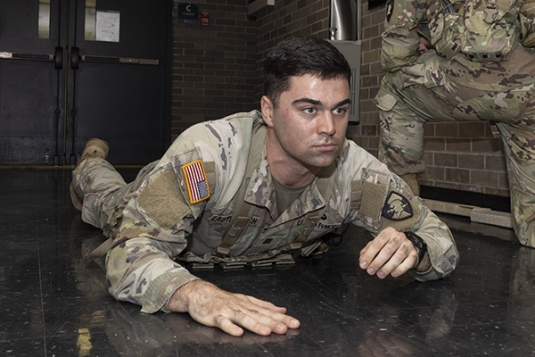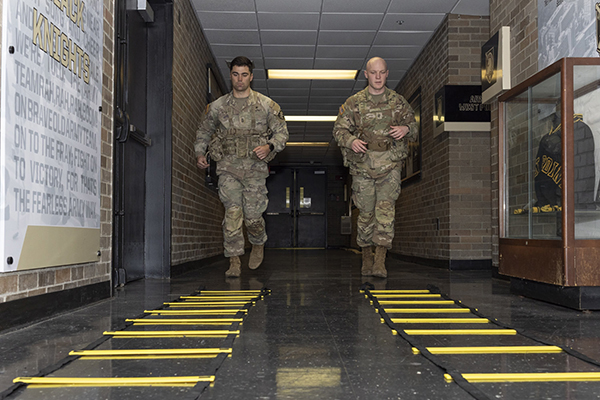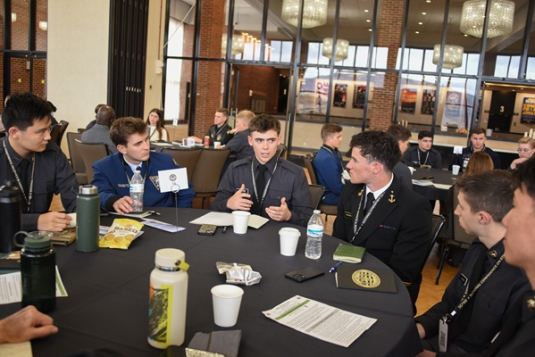Innovation is embedded in the DNA of cadet leadership and academic exploration. A cadet-led research initiative aimed at enhancing Soldier mobility and comfort by optimizing tactical gear recently demonstrated this commitment, yielding impactful results for both soldier readiness and the future of warfighting.
The research project, conducted by CDTs Margaret Kroening ’25, Garrett Lauterbach ’25, and Dylan Howard ’25, focused on how different military kit designs affect soldiers’ comfort and mobility, particularly under heavy loads. Soldiers today often carry 80-100 pounds of equipment, including their tactical kit, body armor, and rucksack. Even small improvements in how this weight is distributed can significantly enhance combat effectiveness and overall lethality.
Cadets compared the standard-issue Tactical Assault Panel System (TAPS) to an alternative aftermarket solution called the Light Infantry Suspension System (LISS). The key difference between these two designs is how they distribute weight: the TAPS places all the load squarely on soldiers’ shoulders, while the LISS redistributes weight more evenly across both the shoulders and hips.
The cadets tested these kit designs on participants who conducted a series of physical exercises. Participants reported greater comfort and mobility with the LISS system, with the findings regarding comfort while doing physical tests like low-crawling and footwork being statistically significant when compared to the standard TAPS system. Qualitatively, soldiers cited greater comfort, reduced fatigue, and better agility during movements as reasons for their physical test improvements. Overall, the cadet’s research findings supported that LISS was effective in alleviating strain from participants’ shoulders by engaging the hips in load bearing.

Beyond these results, the motivation behind the research reflects a broader commitment to excellence and innovation ingrained in West Point’s cadet experience. The project’s genesis stemmed from a fundamental question cadets are taught to continually ask: “How can we better equip our soldiers to win?”
Cadets were driven by real experiences with the tactical gear they were testing, recognizing that optimizing even a single component of a soldier’s load can dramatically influence their endurance, responsiveness, and lethality in combat situations. Conducting this research imbued cadets with practical experience in navigating uncertainty in what findings their research would yield. They honed problem-solving skills in the development of a warfighter-centric solution and one that has the potential to shape the lives of their future soldiers for the better. They learned firsthand the importance of adaptability, exploring multiple solutions, and recognizing the iterative nature of innovation. CDT Kroening noted that “this research and other projects like it that look at innovation that could mean the difference between life and death are vital to increasing soldier lethality on a constantly changing battlefield.” This experience underscored that soldiers must train how they fight, both in the classroom and on the battlefield.
Projects like these are important to the Army’s broader mission to fight and win America’s wars. Continuous innovation in gear design can directly impact mission outcomes, potentially meaning the difference between success and failure, life and death.
The cadets presented their work at the 2025 West Point Projects Day Research Symposium, where faculty, military leaders, and industry partners learn how emerging technology can meet real operational needs through academic collaboration and hands-on experimentation.
Cadets develop projects through their work in Academic Individual Advanced Development (AIAD) opportunities, research projects, and other academic endeavors—activities that would not be possible without donors supporting the Margin of Excellence at West Point.
The excerpt and images were taken from https://www.army.mil.




